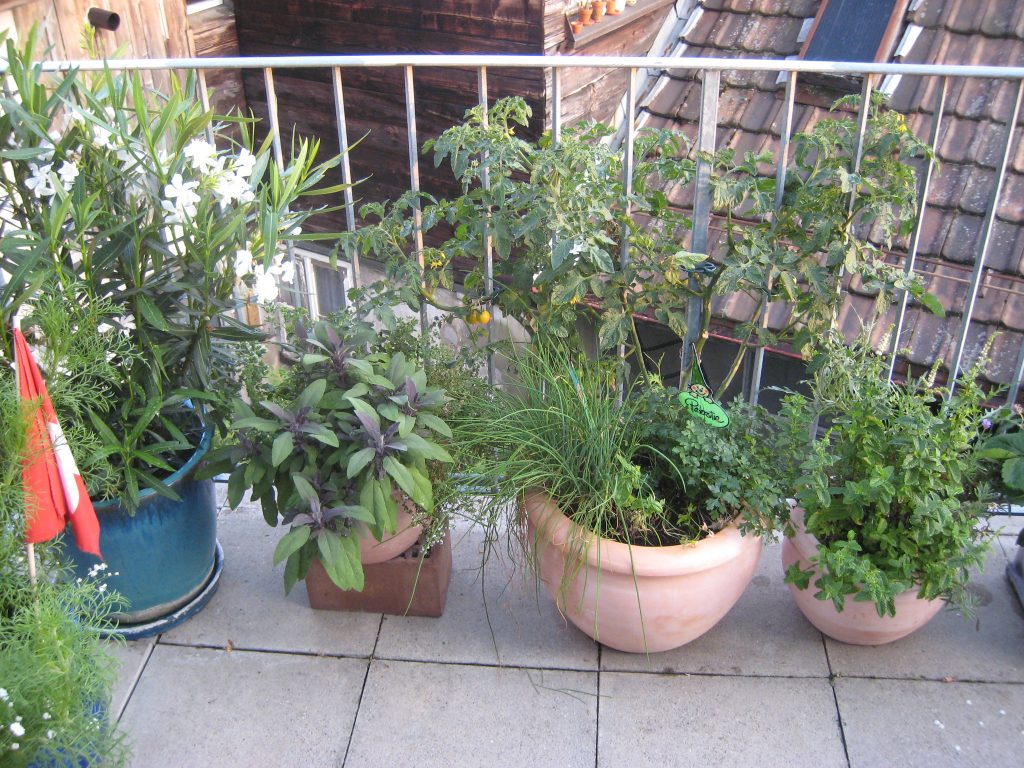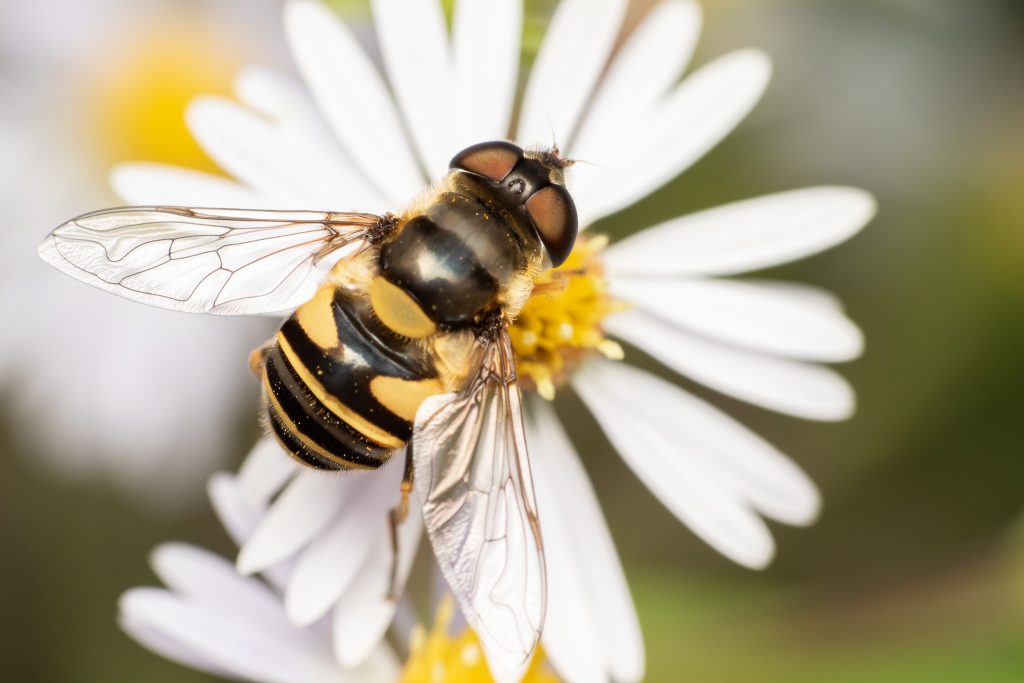As the heat of summer approaches, your quarantine garden will rely on insect pollinators to produce its bounty. Tomatoes. Cucumbers. Heaps of zucchini. This free ecosystem service—pollination—is often taken for granted, but it wouldn’t be possible without the help of insects: bees, butterflies, hover flies, beetles, and wasps.
To support these insect pollinators, you don’t need another garden. Simply let your herbs flower.
Herbs are a group of plants that have at least one organ (leaves, stems roots, flowers) that is tasty or medicinal. Leaves and stems get all the attention, while flowers often get overlooked, clipped away with the dead leaves and added to the compost. Not only are herb flowers almost always edible, but they also offer a veritable feast—nectar and pollen—to pollinators.

Case in point: chive flowers feed sweat bees and carpenter bees after a long winter; the inverted flowering parasols of dill are a favorite of beneficial wasps and hover flies; and you’d be hard-pressed to find a flowering blade of lavender without a bumble bee. Moreover, flowering herbs teach a valuable lesson in pollinator gardening 101. Diversity begets diversity. To support all the pollinators that make your garden productive, plant diverse herbs.

It’s not hard to get started. Compared to pollinator-friendly native plants*, herbs are easy to procure. Seedlings are available for purchase at garden centers and many grocery stores in spring and summer.
Herbs are also conducive to being grown in containers, making pollinator gardening possible anywhere, even on balconies or in window boxes. Herbs are forgiving to grow (sometimes downright invasive, another reason to use a container) and only require regular watering and some direct sun. And best of all? The strong flavor of the leaves that we enjoy in our cooking is despised by rabbits and deer.

When picking out herbs for your garden, my recommendation may seem counter-intuitive: grow what you like to eat. Gardening for pollinators can be more involved, but it doesn’t have to be. All flowering herbs support pollinators. By selecting particular combinations of herbs to grow, however, you can maximize the benefits of your quarantine garden for pollinators. Here are four tips:
- Combine herbs that vary in flower shape (e.g., dill, lavender, borage, chamomile).
- Combine herbs that vary in fragrance (e.g, cilantro, basil, rosemary, lemon balm).
- Combine herbs that vary in size (e.g., thyme, chives, nasturtium, fennel).
- Combine herbs that flower in succession, from spring (e.g., chives, sage, rosemary) to early-summer (e.g. thyme, lavender) to late-summer (e.g., basil, oregano).
Next, put your herbs in the ground or in a pot with plenty of room to grow (6-8” between plants). Water them well at first, then a few times per week or whenever the leaves begin to wilt. If you already have herbs in your garden, even better! You’re ahead of the game.

Harvest leaves and stems throughout the season (morning or early evening is best!). Use them fresh or dry them for later. A few of my favorite things to make with herbs: mint-watermelon cooler, gnocchi with brown butter-sage sauce, and pesto potato salad.** With leftover pesto, I make pesto ice cubes to enjoy garden freshness all winter long.
At some point during the growing season, your herbs will want to flower. The flowering time of the herb depends on its life cycle. For perennial herbs that come back each year, such as chives or sage, the plant will flower at a predictable time each year alongside your harvest. For annual herbs that die at the end of the growing season, such as basil or cilantro, the plant will flower at the end of summer or if it gets too cramped in its container. In both cases, the leaves and stems are still edible while the plant is flowering, but they will be tougher and less sweet than before.***

Letting your herbs flower is a simple, intentional act that sets in motion the dinnertime rush. Take time to notice your guests. Notice how bees push and reach over each other to get food on their plates, family style. How hover flies wait back for the perfect moment to land, so they can eat without being disturbed. How butterflies sip nectar, polite and upright, as if dining at a fine restaurant. Take pride that you’ve put food on their table, just as they have on yours.
*Flowering herbs are non-native, introduced by colonists. That means our native pollinators don’t share an evolutionary history with herbs and, therefore, don’t benefit as much from herbs as they do from native plants. If you’re interested in adding native plants to your garden, check out our handout for recommendations on what to plant.
**Pesto potato salad
- 2 cups quartered baby potatoes
- 1T paprika
- 2T chopped rosemary
- 1c green beans, cleaned and cut into 1in pieces
- 4 roma tomatoes, halved
- 2c fresh basil, loosely packed
- 2T sunflower seeds
- juice of half a lemon
- 1/4c grated parmagiano regiano
- 1/2c extra virgin olive oil + 2T extra for potatoes
- 1 large or 2 small cloves garlic
- salt and pepper to taste
Preheat oven to 400˚F. Toss quartered potatoes in olive oil, salt, pepper, paprika, and chopped rosemary and roast in oven for 35-40 minutes. Meanwhile, blanch green beans in boiling water for 60 seconds, then shock immediately in ice water. Set aside. If possible, grill tomato halves for 8 minutes, until charred and cooked. If not, place in the oven with potatoes for the final 10 minutes of roasting. Dice tomatoes and toss the body of the salad to mix. Dress with pesto (see below). Enjoy!
Earlier that same day (or while potatoes are roasting), prepare pesto. Process together basil, sunflower seeds, lemon juice, garlic, cheese, and s&p, slowly drizzling olive oil into the blender to emulsify and incorporate. Adjust seasoning to taste.
***Nick’s tip: If you want to delay the flowering of your herbs, perennial or annual, clip off incipient flower buds. Do this when the buds are small.












